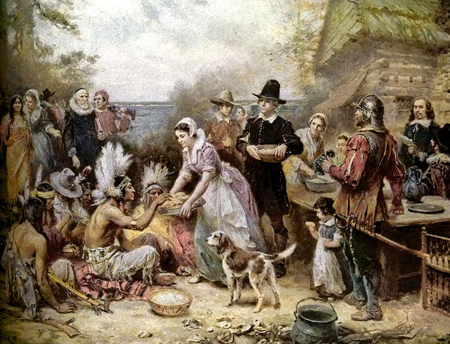
"The origins of Thanksgiving predate the Pilgrims by at least 2,000 years. After the harvest of each year was safely stored for the winter, Celtic priests would mark the end of their calendar with prayers to their sun god for protection during the period of darkness and cold of winter. These harvest festivals evolved and much later became combined with a Christian Feast of Saints. But most Americans hark back only to the Pilgrims of Plymouth Rock holding their Thanksgiving in 1621 as a three day "thank you" celebration to the leaders of the Wampanoag Indian tribe and their families for teaching them the survival skills they needed to survive in the New World. Sounds too much like a Hallmark moment, but the vision of that day has been rooted deeply in our psyche not by historians, but by artists. If you stop and think about it, you probably see Thanksgiving in a very visual manner. The holiday has been engrained into our memories from as early as grade-school, almost all of it based on presentations influenced by artistic renderings of the day. Truth is, whenever a Pilgrim, or more accurately, a generic 17th-century Puritan image appeared in popular art in connection with Thanksgiving during the nineteenth century, it was not the now familiar scene of English and Indians sitting down to an outdoor feast. On the contrary, the image almost always portrayed a violent confrontation between colonist and Native American. It was only after the turn of the century, when the western Indian wars were over and the "vanishing red man" was vanishing satisfactorily, that the romantic, idyllic image of the two cultures sitting down to an autumn feast became popular." Get the Story:
ArtScene: Thanksgiving: Based on a Myth? (The Huffington Post 11/22)